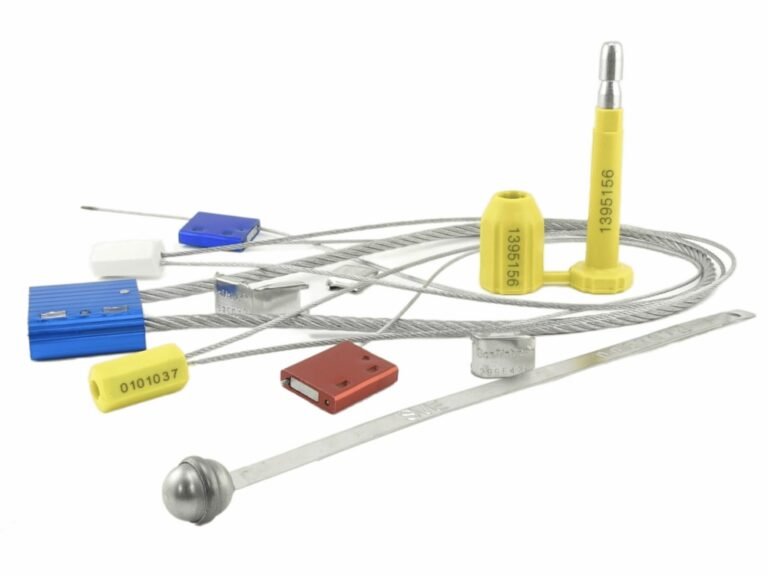Managing security for a massive fleet is a complex nightmare of routes, drivers, and cargo values. A one-size-fits-all approach either wastes money on over-protection or invites catastrophic losses from under-protection.
The solution is not about finding the "best security seal"; it's about designing a "best-fit," tiered security system. By matching the right seal to the right risk level, you can optimize security, efficiency, and cost across your entire fleet, just like managing an investment portfolio.

Over the last twenty years, I've worked with fleet managers from global logistics giants to regional distributors. Their biggest challenge isn't a lack of budget or technology. It’s complexity. How do you create a single, unified security standard for hundreds of trucks, different routes, and constantly changing cargo? They don't need another product pitch. They need a system design consultant who can help them simplify this chaos into a coherent, cost-effective strategy. Let's design that system.
What is the Biggest Issue in the Trucking Industry?
Is your primary focus on preventing brute-force break-ins? While important, this narrow view overlooks the real operational cancer that erodes fleet profitability: uncontrolled complexity in your security protocols.
The single biggest issue is the lack of a scalable, tiered security system. Without it, managers are forced into a binary choice: either overspend on high-security seals for low-risk routes or accept unacceptable risk on high-value cargo, leading to inefficiency and financial loss.
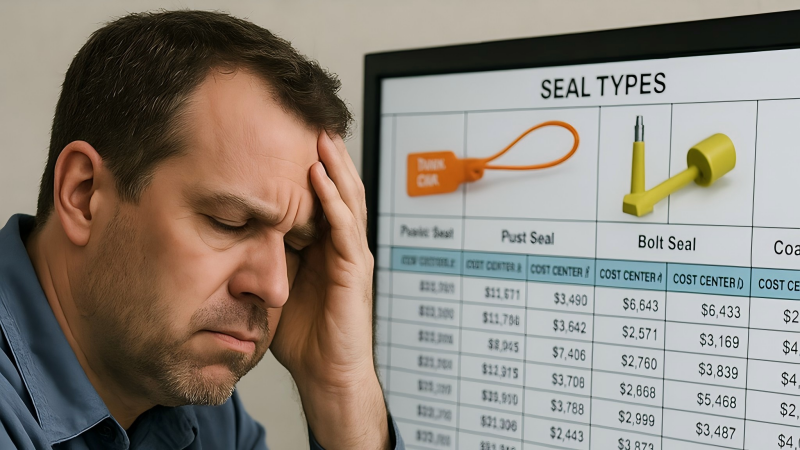
My core philosophy is that a successful sealing strategy is about building a "best-fit" system, not just picking the "best" seal. Think of it like managing an investment portfolio. You wouldn't put all your money into high-risk stocks, nor would you put it all in low-yield bonds. You diversify. Similarly, your fleet's security "portfolio" should be layered. A simple, indicative plastic seal for a low-risk local shuttle route (your bond), and a high-security, ISO-compliant bolt seal for a cross-border shipment of electronics (your blue-chip stock). The goal is to maximize the risk-adjusted return for the entire fleet, ensuring every dollar spent on security is working as efficiently as possible.
Understanding the Security Spectrum: From Indicative Seals to High-Security Barriers?
Do you feel lost in a sea of seal types, unsure where one's job ends and another's begins? This confusion leads to poor choices, leaving you with either a false sense of security or a needlessly high budget.
The security spectrum is simple: at one end, you have indicative seals designed purely to show evidence of tampering. At the other, you have high-security barrier seals designed to create a strong physical obstacle, slowing down and deterring thieves.
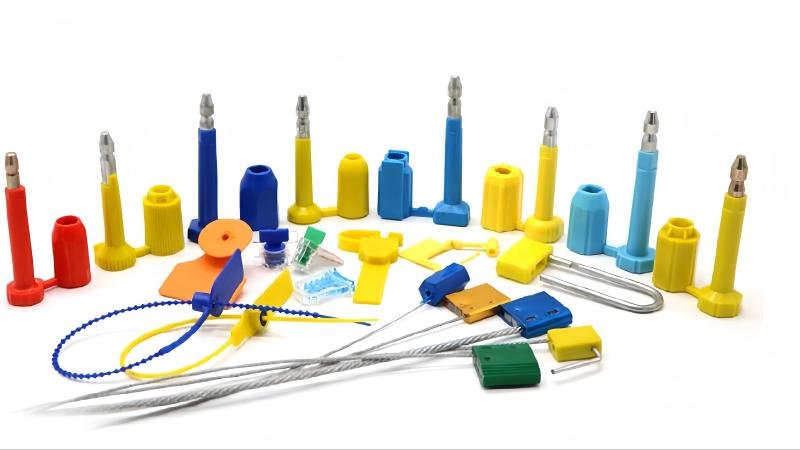
Let's break down the "assets" in your security portfolio. Understanding their specific roles is the first step in designing your system. Indicative seals, typically made of plastic, are your first line of defense for process control. They won't stop a determined thief, but they provide instant proof that a chain of custody was broken. They are low-cost and ideal for low-risk, high-volume movements. High-security seals, like bolt and heavy-duty cable seals, are true barriers. They are made of hardened steel and require specialized tools to remove. Their job is not just to provide evidence but to actively prevent or delay intrusion, protecting high-value goods on high-risk routes. Choosing the right one is about defining the goal: are you looking for evidence or prevention?
The Fleet Manager's Decision Matrix: Balancing Cost, Cargo Value, and Risk?
How do you decide which seal to use for which shipment without it being a complete guess? Making inconsistent decisions across a fleet of hundreds is a direct path to security gaps and wasted spending.
A simple decision matrix is the solution. By evaluating every shipment against three core criteria—Route Risk, Cargo Value, and Compliance Needs—you can standardize the seal selection process, ensuring consistency, safety, and cost control across your entire operation.
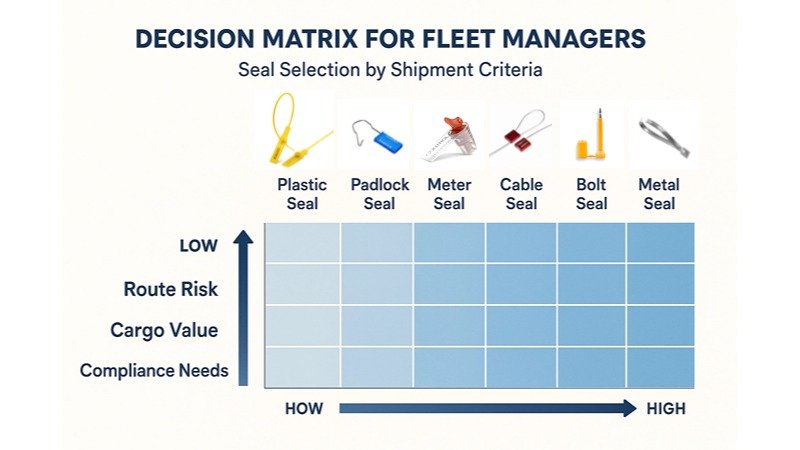
This isn't theoretical; it's the practical tool I help fleet managers build. It removes guesswork and empowers every member of your team to make the right call. The logic is straightforward. A cross-country route through known cargo theft hotspots is high-risk. A sealed pallet of low-value retail goods is low-value. A shipment crossing the U.S.-Mexico border has a non-negotiable compliance requirement. By mapping these factors, the correct seal choice becomes obvious. This systematic approach is the engine of a successful, tiered security strategy. It ensures you never use a $1.50 bolt seal where a $0.20 plastic seal will suffice, saving you thousands while simultaneously hardening your most vulnerable routes.
| Scenario | Route Risk | Cargo Value | Compliance | Recommended Seal |
|---|---|---|---|---|
| Local Retail Delivery | Low | Low | None | Indicative Plastic Seal |
| Regional Pharma Haul | Medium | High | None | Heavy-Duty Cable Seal |
| Cross-Border Electronics | High | High | T-PAT Mandatory | High-Security Bolt Seal |
| Inter-Warehouse Transfer | Low | Medium | None | Plastic Pull-Tight Seal |
Beyond the Lock: Navigating Critical ISO 17712 and C-TPAT Compliance?
Are you treating international compliance standards as a bureaucratic headache? This mindset is dangerous, as a single non-compliant seal can get your shipment seized, incurring massive fines and delays.
ISO 17712 is the global standard that certifies the physical strength of a seal, while C-TPAT is a U.S. Customs program that requires its use. For any international shipper, these aren't optional; they are a fundamental requirement for business.
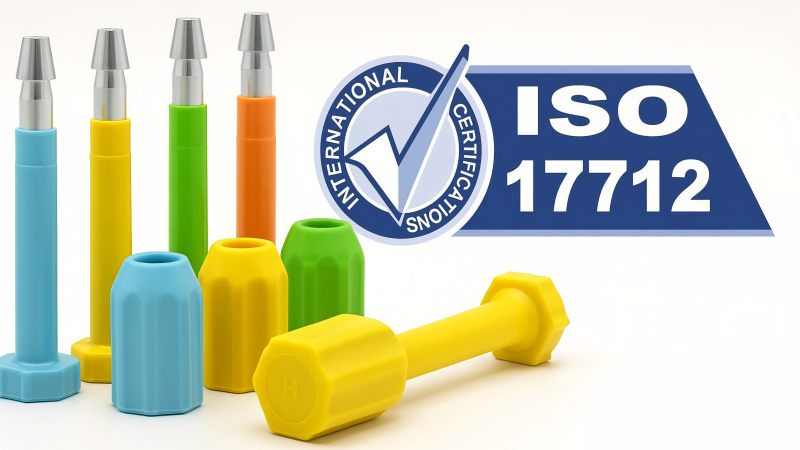
As a system designer, I see compliance as the foundation of your high-security tier. If your fleet crosses borders, your policy must be black and white: any shipment subject to C-TPAT regulations must use a high-security seal that is independently certified to be ISO 17712 "H" class compliant. There is no gray area here. The pitfall I've helped many managers avoid is buying seals from a supplier who claims compliance without providing third-party certification. You need to see the paperwork. This isn't just about the seal's strength; it's about proving to customs authorities that you have a secure, documented supply chain security process. It's your license to operate in the global market.
From Policy to Pliers: Your Blueprint for Implementing a Fleet-Wide Sealing Protocol?
Do you have a great security policy on paper that no one follows in the yard? A protocol that isn't simple, repeatable, and enforced is completely useless and a waste of everyone's time.
The key to implementation is a simple, non-negotiable protocol that covers the entire lifecycle of the seal: Application, Verification, Documentation, and Removal. This blueprint turns policy into consistent, real-world action.
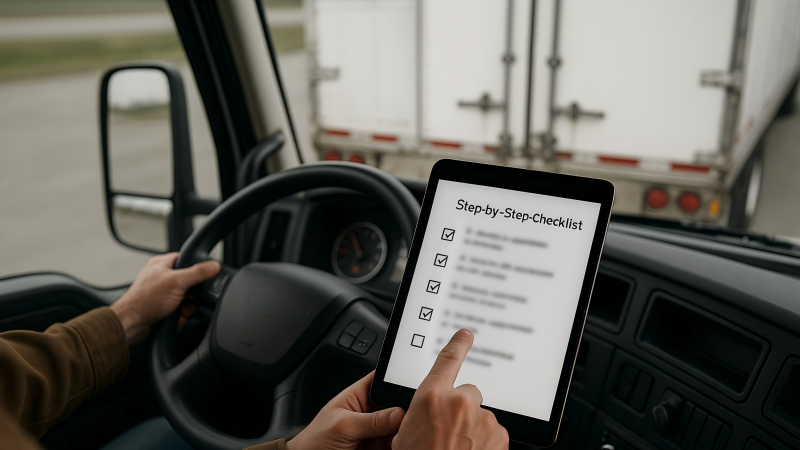
Here is the four-step blueprint I implement with fleets. First, Application: Train staff on the proper way to apply each seal type to ensure it's securely locked. Second, Verification: Mandate the "VVTT" check (View, Verify, Tug, Twist) and require the serial number be recorded on the manifest. Third, Documentation: Require a time-stamped photo of the applied seal at the point of origin and of the intact seal at the destination before removal. This creates an undisputed digital record. Fourth, Removal: Specify who is authorized to remove the seal and what tool (e.g., bolt cutters for bolt seals) must be used. This simple, repeatable process takes the complexity out of execution and creates a culture of security across your entire team.
Conclusion
Stop searching for the single "best" seal. Instead, build a smart, tiered security system for your fleet. Match the seal to the risk to optimize protection, control costs, and simplify your operations.
Let's Design Your Fleet's Security System
ProtegoSeal is more than a supplier; we are system design consultants. We can help you analyze your routes and cargo to build a tiered sealing strategy that maximizes security and minimizes cost. Contact me to create your fleet's custom security portfolio.

